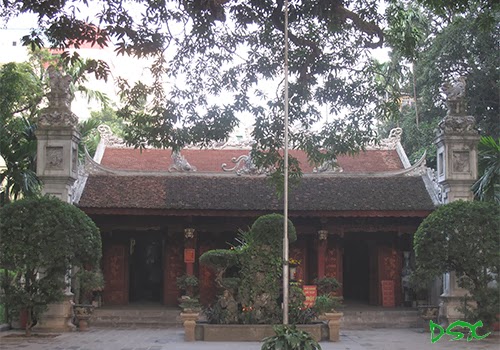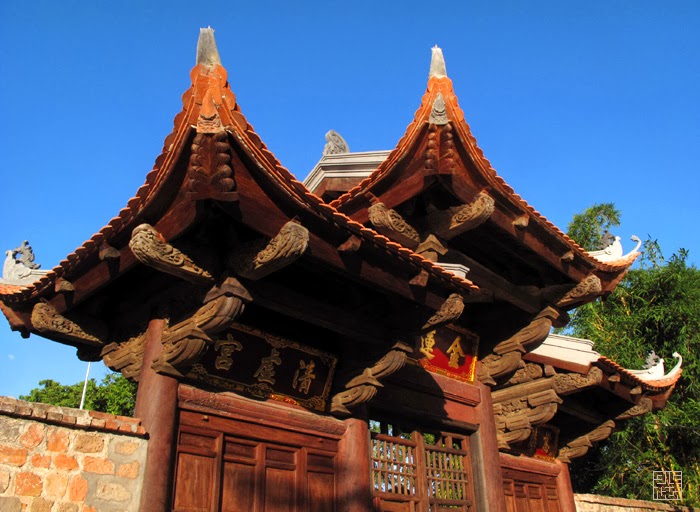Hanoi, the capital of Vietnam with many famous destinations, one of the most famous things of Hanoi is the four ancient temples known as “Thang Long four guardians”. It is the normal name of
4 sacred temples in Hanoi that are located in 4 main directions of ancient
Thang Long: Bach Ma temple in the East, Voi Phuc temple in the West, Kim Lien
temple in the South and Quan Thanh temple in the North. For many years of
history, “Thang Long 4 guardians” still remain until today and it has become
the pride of Hanoian for their both sacredness and famous destinations.
Guardian of the North – Quan Thanh temple |
Quan Thanh
temple was built about hundred years ago, under the Ly dynasty with the purpose
to worship Tran Vu God, the one who takes care of the martial art in heaven. Located
near Hanoi West Lake with nice view and sacred atmosphere, after many time of
repairing, nowadays, Quan Thanh temple is famous for its architecture of the 17th
century.
 |
| Quan Thanh Temple |
Quan Thanh temple included: Tam Quan gate (three doors gate), Temple
yard and the three main buildings: Front hall, annex, back hall.
 |
| Main Hall of the temple |
Inside Quan
Thanh temple, there is a 4 meter height – black copper statue with the weight
of nearly 4 tons. This statue named Huyen Thien Tran Vu and it was built in 1677 to show the respect of local
people to the Gods worshipped here.
 |
| Huyen Thien Tran Vu Statue |
Besides the copper statues here, Quan Thanh
temple is also famous for its wood-carving architecture. On the wood parts of
the temple, there are images of holy animals like dragons, phoenix, bats; some
kinds of beautiful flowers that shows the uniqueness of Le dynasty in 16th
century.
 |
| Carving on the Altar |
Guardian of the South – Kim Lien temple
Kim Lien
temple is built in honor of Saint Cao Son, one of the 50th son of Lạc
Long Quân and Âu Cơ (ancestors of the Vietnamese nation). Cao Son followed his
father to the mountains and is one of two deities worshipped in the Tan Vien
Mountain temple. Cao Sơn was the deity
who secretly contributed to helping King Le Tuong Duc quell the rebellions in
Dong Do, so the King decided to build Kim Lien Temple in 1509 to worship him.
Kim Lien
Temple is located on a high hill and consists of two separate parts: in front
of the hill is the arched gate and the main structure on the hill itself.
 |
| Kim Lien temple gate |
The four
sets of pillars propping up the roof are designed in the traditional
architectural style with vivid and sophisticated decorative motifs typical of
the Nguyen Dynasty art (19th century).
 |
| Beautiful gate of Kim Lien |
The entrance
gate is a three compartment chamber with lively decorative details such as
phoenixes keeping books in their mouths, clouds, an unicorn.
 |
| Decorations of the temple |
This temple
consists of a grand ceremonial hall – which restore in 2000, on the occasion of
Hanoi’s 990th founding anniversary – and a three-compartment back sanctuary.
Inside the sanctuary, the front compartment is where a common altar is placed;
compartment is where a ritual throne and ritual weapons are installed, and the
back compartment is where the statues of Saint Cao Son and two other goddesses
are worshipped.
The most
important relic in the Kim Lien Communal House is the stone stele of “Cao Soon
God’s contribution,” written in 1510, telling of Cao Son’s efforts to help KingLe regain his throne from troublesome members of his family.
Guardian of the East – Bach Ma temple
The
temple was built in the 9th century, worships Long Do, the
deity who protected the Thang Long Royal Citadel. In 1010, Ly Thai To king
moved the citadel from Hoa Lu (Ninh Binh) to Thang Long and wanted to expand
it. The king asked the troops to build the citadel higher, but whenever they
did that, the citadel collapsed. The king asked people for the reason and knew
that this place was awe-inspiring powerful earlier. Then he ordered to make
offerings. At that night, in his dream, he met the deity who congratulated and
told the king to follow the traces of horse hooves to build the citadel. Then
the king saw a white horse galloping at full speed and then disappeared. On the
next day, the king saw the traces of horse hooves on the ground in a circle and
instructed the troops to follow them for the construction. The citadel was
built very firm. To express the gratefulness to the deity, the king asked for
carving a white horse for worshiping and conferred the title of “Thang Long
tutelary god”. From that, the white horse has become a sacred symbol and Bach Matemple (or white horse temple) has been known from that.
 |
| Bach Ma Stele |
The temple now still keeps lots of old valuable relics such as stone steles, palanquin, cranes and pairs of toy earthen statue for worship.
Bach Ma temple is a very nice architectural work which includes three-door temple gates, burning incense place and forbidden palaces. It is a closed architectural work, making the temple become among rare and typical works of the Northern delta region.
 |
| Bach Ma main gate |
Every
year, to honor Long Do deity, the People’s Committee of Hoan Kiem district
holds Bach Ma temple festival on lunar February 12 and 13. The event includes
many offerings and cultural activities like ceremonial songs, Vietnamese
popular opera, poem recitation and fencing.
 |
| Bach Ma Main Hall |
Being
one of the gates of “Thang Long four gates” and located in favorable location
for cultural tourism development, Bach Ma temple is not only meaningful to Hanoi
people and visitors but also provides valuable sources of documents for
studying the thousand-year history of Thang Long - Hanoi
Guardian of the west – Voi Phuc temple
Voi Phuc Temple is located inside the
precinct of Thu Le Zoological Garden, belonging to Ngoc Khanh Ward, Ba Dinh
District, Ha Noi. The temple worships Linh Lang who is known as one of four
Guardian Gods - Thang Long Citadel's Western Guardian God
 |
| Rocky Elephant in the temple |
Voi Phuc (Kneeling Elephant) Temple was built during the
reign of King Ly Thanh Tong (1054 - 1072), dedicated to Royal Highness Linh
Lang - Linh Lang God. Therefore, it is also known as Linh Lang Temple.
To remember the merits of the prince, King Ly Thanh Tong
bestowed the title His Royal Highness on Linh Lang and built the temple in his
honour. In front of the temple are two kneeling elephants, hence the name Voi
Phuc is called by the residents. The place of Voi Phuc Temple is also a
historical relic.
 |
| Temple main gate |
Over the vicissitudes of history, the temple was heavily
damaged. From 1953 to date, this temple has been renovated several times.
Today, besides two elephants kneel in front of the temple, there are objects in
the temple such as two bronze statues; a sacred stone with indentations;
parallel sentences that praise the merits of the Thang Long Citadel's Western
Guardian God.
Every year, to commemorate the merits of Linh Lang God,
Voi Phuc Temple Festival is held on the 9th to the 11th day of the second lunar
month. This is a Grand procession festival with flags, fans,
gongs, drums, parasols, bat am (cantanets) musical band and senh tien group
dancing.



